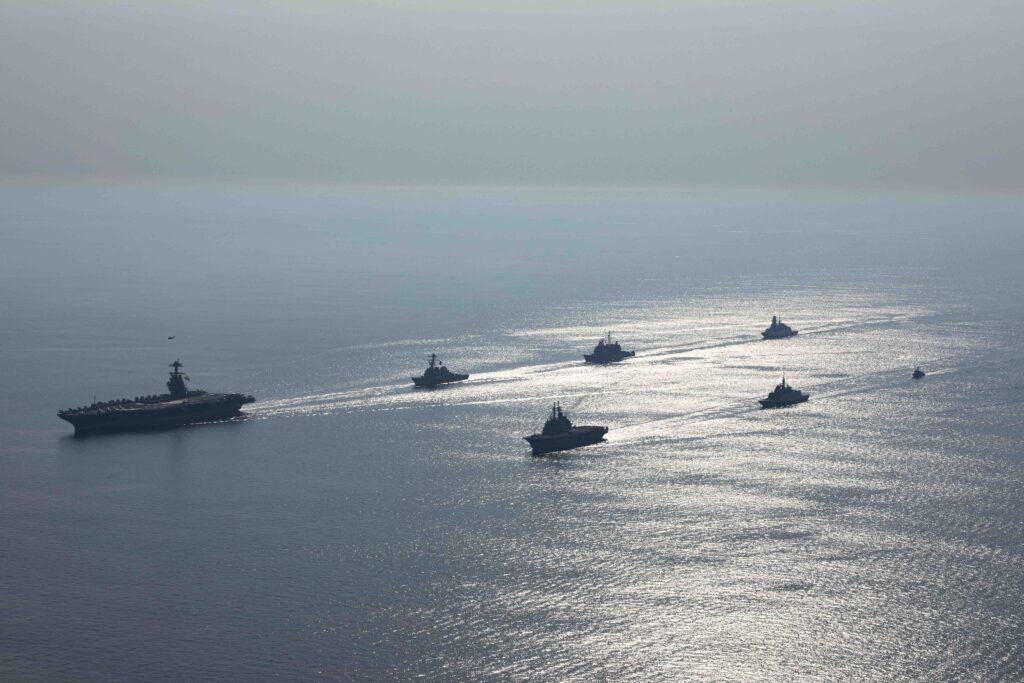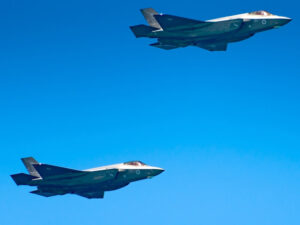A New York Times article earlier this month on the U.S. Navy’s struggle for change was poorly received by the wider naval community and attacked as uninformed on many issues, but most especially on the acquisition of cheaper, more numerous unmanned systems as advocated in the article.
The article suggests that the Navy, aided and abetted by legislators from shipbuilding states, is producing an expensive, “20th century” Navy ill-suited to modern warfare. Specifically, the article criticizes the Navy for building large, multi-mission warships that the Ukraine War has proven are vulnerable to missile and drone attacks.
The piece also suggests that while the Navy has experimented with many small, and far less costly, uncrewed ships such as those in the 5th Fleet’s Persian Gulf Task Force 59, the service continues to spend most of its funds on larger, traditional and more vulnerable warships. The article further says that the acquisition system for warships is too slow and dated to provide ships rapidly to the fleet, and that wargames held by several institutions suggest that conventional naval forces would suffer heavy losses in a war with China.
The article poses legitimate questions that deserve cogent answers beyond the naval “chattering class’” disapproval.
The Navy has indeed struggled over the past quarter century to implement changes in a challenging budget environment.
The evidence of struggle is clear.
- For example, recent wargaming results suggest that the Navy’ crown jewel platforms, including aircraft carriers, destroyers and even submarines, are vulnerable to adversary defenses.
- What’s more, shipyards are part of the problem, especially when they build controversial ships like the Littoral Combat Ship (LCS) and the DDG 1000 Zumwalt–class destroyer, both of which have struggled to achieve operational capability.
- Also, what ails the Navy is that it desperately needs a maritime strategy to inform its operations and force design — as it had in the 1980’s that specified fleet size and force design. Without such a specific plan in place, shipyards are likely to see mixed messages in demand signal, as a fleet size without a strategy in support has always been subject to cuts.
Difficulty deploying new weapons systems
Many organizations struggle with change, and the Navy is no different.
While often labeled an organization steeped in “tradition,” the Navy is more closely wedded to being “operational” in forward deployment. Many of the Navy’s recent efforts at change are linked to that desire. Trying to reduce crew size, deploy more ships from a shrinking fleet and do even more with even less so that it can keep one-third of its fleet constantly deployed (as Pacific Commander Adm. Samuel Paparo recently said in a 60 Minutes interview,) is at the core of the Navy’s self-identity.
The service has struggled however to rapidly deploy new capabilities like unmanned systems due to the nature of the defense acquisition system and the specter of recent problematic ship classes such as LCS and DDG 1000.
The defense acquisition system, originally developed by Defense Secretary Robert S. McNamara in the 1960s, favors evolutionary versus revolutionary change, like unmanned systems the Navy is planning.
The acquisition system and test and evaluation system he created demand that new defense programs (ships, aircraft, vehicles, missiles, etc.) must pass a rigorous course of analysis and testing to be approved for production. LCS and DDG 1000 ran afoul of that system as their failures of system tests delayed their fleet entry, made for longer periods of spending and resulted in much more expensive ships than ever intended..
The slow and deliberate acquisition system to a large degree is in conflict with the Navy’s current plans for unmanned platforms. Indeed, the current acquisition system would need major overhaul to support the rapid fielding of credible new systems in numbers..
The legislative branch is decidedly skeptical of what the Navy is now doing with unmanned systems as a result, and the service must again earn the trust of Congress through a thorough unmanned systems program that passes tests and does not have ridiculously high costs.
Unmanned and manned systems in the works
The Navy is exploring unmanned surface ships as eyes and ears of the fleet (as explored in Task Force 59) and as missile shooters. The uncrewed Boeing M/Q-25A tanker aircraft is on the verge of joining the fleet, and it will vastly extend the range of the F/A-18 E/F and F-35C aircraft, as well as serving as a potential strike platform.
The large, unmanned underwater vehicle (XLUUV) continues testing as a potential scout, minelayer and weapon-armed “loyal wingman” of the manned submarine force. The Navy Sea Systems Command (NAVSEA) Unmanned Systems and Small Combatant (PEO USC) office has many lessons learned from LCS and is proceeding with caution to develop stable systems that can earn congressional approval.
These systems, as well as the new carriers, destroyers, frigates and submarines, are 21st century platforms with capabilities far greater than their 1980s-era counterparts. The challenge is that the Navy must build them to achieve safe passage through the defense acquisition system with good stewardship of public funds as a priority.
Expansion of the fleet, both in crewed and uncrewed platforms, will require more funding to reach levels capable of globally contesting U.S. adversaries, so it is a good thing that the New York Times is asking these questions on uncrewed systems given past problems.
Wargames don’t tell the whole story
Another major challenge is the outcome of recent war games in which the Navy has come in for criticism due to the poor performance of its “crown jewel” platforms. The wargames showed that the Navy would lose at least two aircraft carriers, all of the escorts for those ships and nearly 200 aircraft in battle against China due mainly to its land-based missiles and missile-armed aircraft.
These games, however, deal only in pure numbers (ranges and numbers of weapons) but not with what the Naval War College often calls “intangibles,” which include opponent motivation, level of political involvement in and direction of military action and adversary military doctrine. U.S. wargames have sometimes “mirror-imaged” opponents by assuming that opponents would act with their forces as would a U.S. commander.
The U.S. has made similar mistakes in the past. In the 1970s it was assumed that the Soviet Navy would launch a World War II-style counter-commerce campaign against NATO resupply in Europe. The Soviets possessed over 300 submarines and such a campaign seemed logical. Signals intelligence and other means, however, determined that Soviet submarines would primarily defend their ballistic missile submarines and support the Soviet Army rather than attack NATO convoys.
Likewise, many experts believed the modern Russian Army was a highly effective organization based on observation of decades of Russian military exercises like ZAPAD. The actual Russian performance turned out quite different when they invaded Ukraine.
Wargames offer potential options but are never solutions by themselves.
Shipyards are not the problem
Shipyards often get maligned as defense contractors that exploit the government for additional work or get the government to pay for things it does not want. Problematic ship classes like LCS and DDG 1000 reinforce that thinking.
Shipyards are a business like any other and do business development for more work. But they also build what the Navy proposes and Congress funds. Shipyards have been the victim of an “uneven demand signal” from the Navy for many years on how many and what types of ships to build. Such uneven construction periods make it difficult to hire, train and retain qualified shipbuilders over time. If a builder has not been asked for several years to build multiple vessels in one year, that company may need time to hire and train enough people to support Navy shipbuilding goals.
Shipbuilders are successful companies but are not robber-baron capitalists. They have a 5% to 7% profit margin per year, where big tech companies often exceed 20% profit margins. Many U.S. shipyards do not also build civilian ships and are therefore dependent on government funding in a monopsony arrangement.
The shipyards are not a “military industrial complex,” nor an adversary in changing the Navy. They need a steady building program to stay viable over time. Given that, they would likely build the revolutionary systems desired. But those systems just need to be mature and pass system testing so that taxpayer funds are not wasted repetitively in the same work.
Banding together to support change
Changing the strategy and the force structure of any military service never occurs as fast or as comprehensively as advocates desire. Whole institutions grow up in the service around specific types of ships and operating concepts. It took the Navy decades to fully accept the aircraft carrier and the submarine, with the value of those platforms only being fully visible in hindsight.
Unsuccessful programs like LCS and DDG 1000 cause lawmakers, citizens and naval officers to be more circumspect about radical change. The Navy, however, is pursuing multiple types of unmanned systems. It conducts regular wargames such as the recent Lage Scale Exercise 2023 that examine warfare in a global context for lessons on strategy, operational planning and tactics as well as force design.
Shipyards will build what the Navy desires and Congress funds if they are given a regular demand signal so that they can keep skilled workers on their payrolls.
Journalists will continue to investigate and ask questions about these issues. Rather than be defensive, navalists should strive to provide cogent answers to those inquiries, no matter how uninformed they might seem.
Everyone is on the same team in desiring a capable and affordable Navy that meets national security and national defense requirements in the 21st century.







